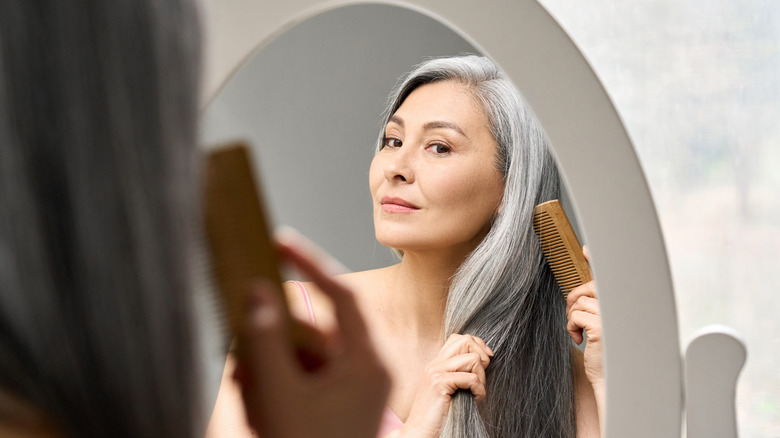When Should You Expect To Start Getting Gray Hair (And What You Can Do To Prevent It)?
Have you just noticed a few gray hairs, and now you're wondering what to do about them? Rocking your gray hair can be empowering, but not everyone is ready to take the leap. Until recently, this hair color was associated with old age, although it's possible to go gray in your 20s or even earlier.
Contrary to popular belief, gray hair isn't necessarily a sign of aging. "People who have high or low thyroid [levels] and people with some autoimmune diseases that knock off the hair follicles may also go prematurely gray," said OB-GYN Kirtly Parker Jones in an interview with the University of Utah. Stress, genetics, and ethnicity play a role, too. For example, a 2018 study found that Caucasians tend to go gray earlier than African Americans, reports the International Journal of Trichology. Alcohol consumption, smoking, pollution, and sun exposure can speed up this process.
The question is, when should you expect to start getting gray hair? Is it normal to go gray in your 30s or earlier? The answer depends on several factors, including your lifestyle habits. In some cases, this process can be reversed by addressing its root cause.
The age you go gray depends on your genes
Your hair, skin, and eyes get their color from melanin, a naturally occurring pigment. Its production decreases over time, causing the hair to turn gray. The likelihood of going gray increases by 10% to 20% per decade after age 30. But, as discussed earlier, aging isn't the only factor involved in this process.
"Chemicals like hair dye or products for hair straightening can cause damage to the hair fiber. Smoking can increase the rate of hair aging," explained Neelam Vashi, the founder of the Center for Ethnic Skin, in an interview with Dermatology Times. Your cultural background comes into play as well, says Vashi. "It's not just how you were born and your genetics but also your culture and what you do," she added. Premature hair graying may also be due to oxidative stress, nutrient deficiencies, inflammation, and certain drugs, according to the International Journal of Trichology.
Caucasians usually start noticing their first silver strands around age 34. However, this process can just as well occur in your mid-20s or after age 40, depending on your genes. Black people start going gray in their mid-40s, whereas Asian people will experience these changes in their late 30s, notes Vashi. Regardless of race, up to 23% of people will have 50% gray hair by the time they turn 50.
Is it possible to prevent or reverse gray hair?
Hair graying is a normal part of aging, but it might be possible to delay or reverse this process. Plus, there are ways to hide gray hair without dying it, especially if you only have a few silver strands. First, it's important to know that stress-related hair graying may be temporarily reversed, suggests a 2021 study featured in eLife. For example, one of the study's participants started to go gray because of stress. His hair returned to its normal color after a low-stress period followed by a two-week vacation.
Another study, which was published in the 2019 edition of Dermatologic Therapy, states that premature hair graying may be reversed by addressing its underlying cause. The International Journal of Trichology confirms this claim, saying it's possible to reverse hair graying caused by nutrient deficiencies, such as low levels of protein, iron, or copper. "But the hairs that have been gray for 30 years are probably unlikely to be reversible," said neuroimmunologist Martin Picard, Ph.D., in an interview with TODAY.
As far as prevention goes, it's essential to limit stress and eat a balanced diet, suggests the International Journal of Trichology. Go one step further and quit smoking, which is a contributing factor to oxidative stress and aging. The experts at Chester County Hospital recommend eating foods rich in protein, zinc, iron, and vitamin B12 to prevent gray hair. Also, avoid spending long hours in the sun and cut back on alcohol.

